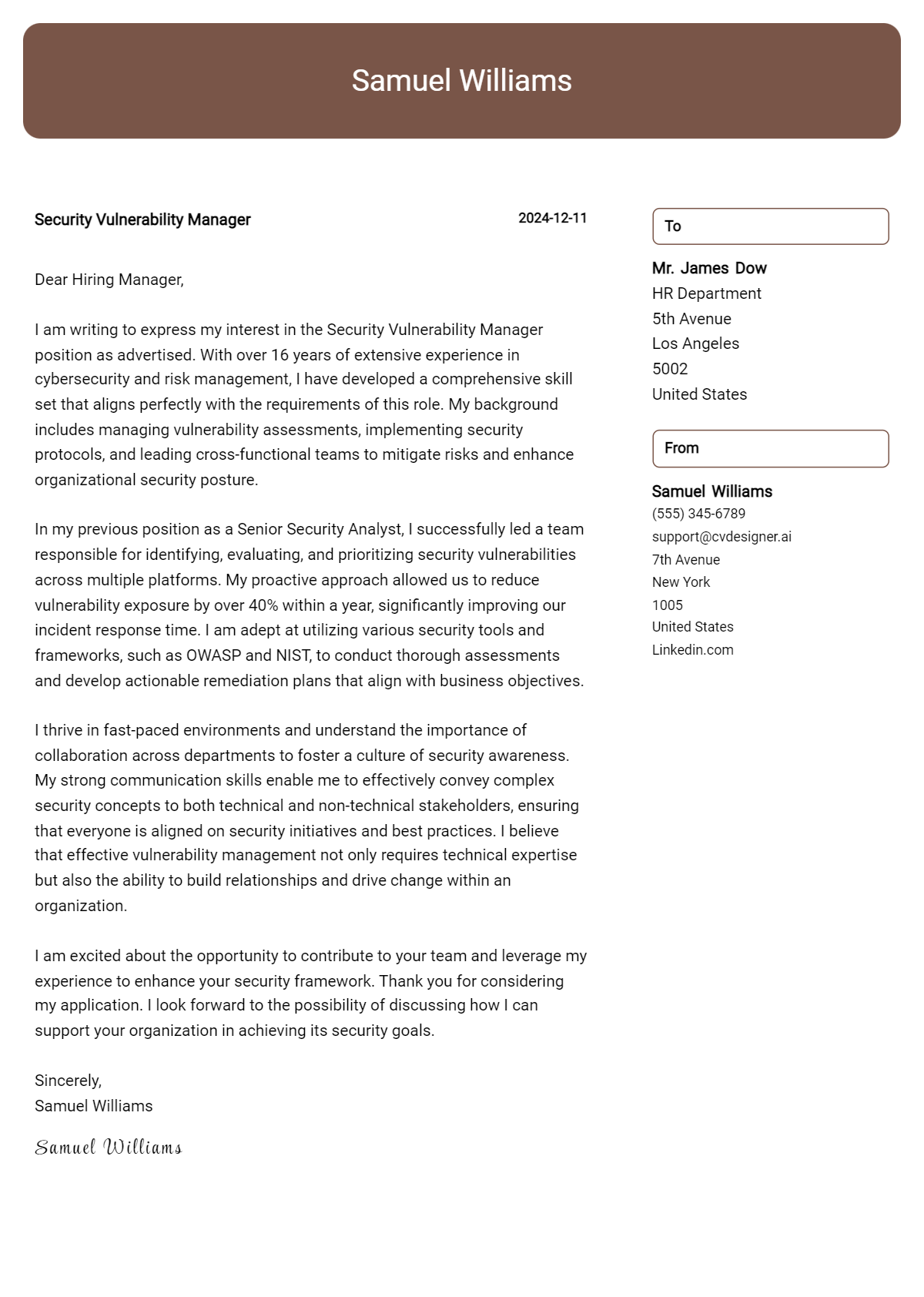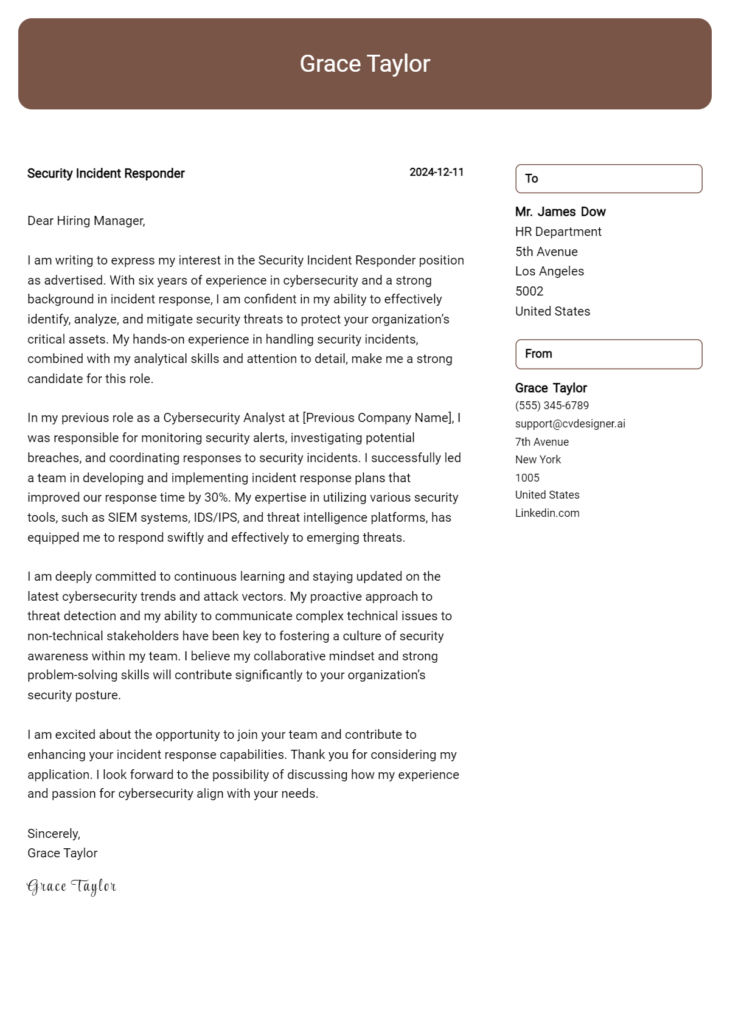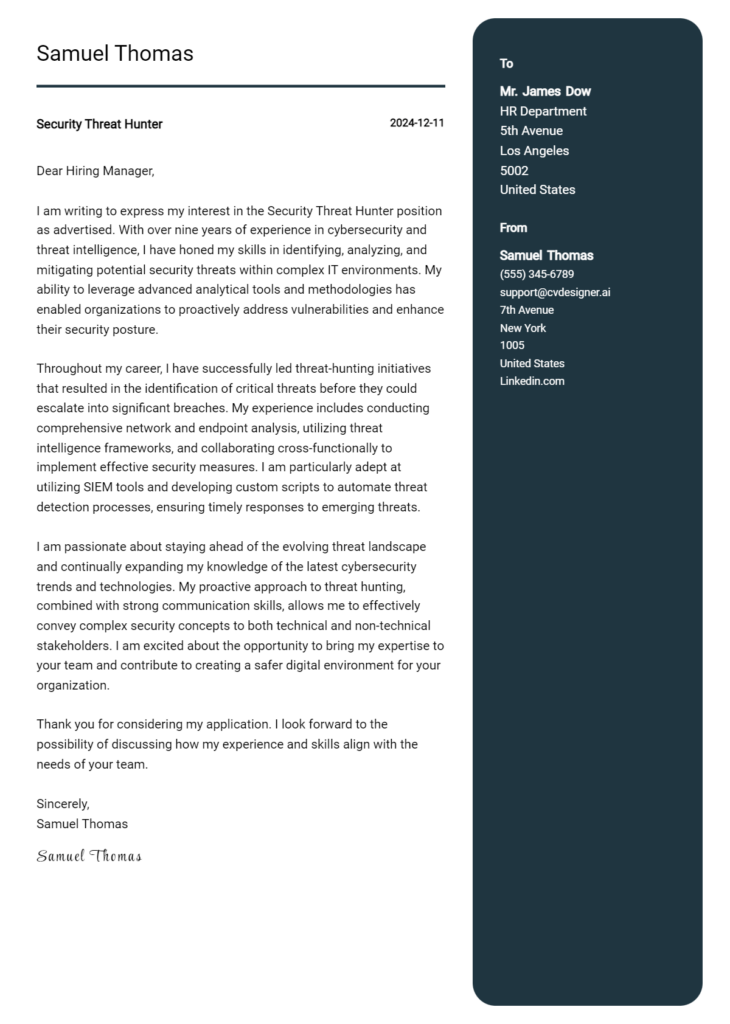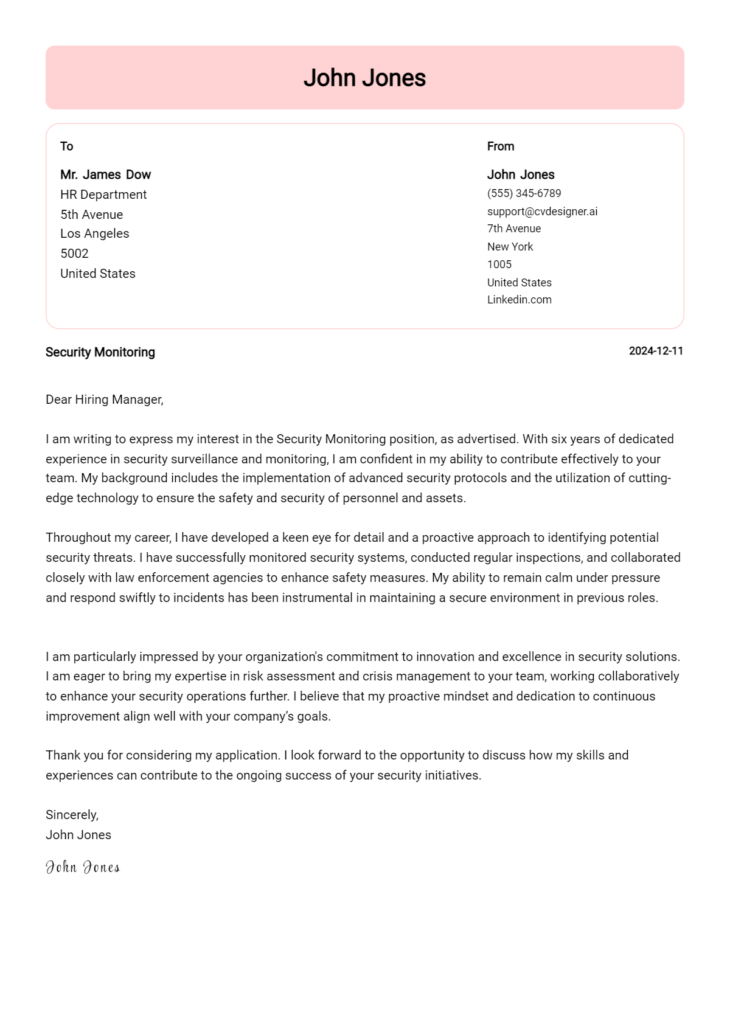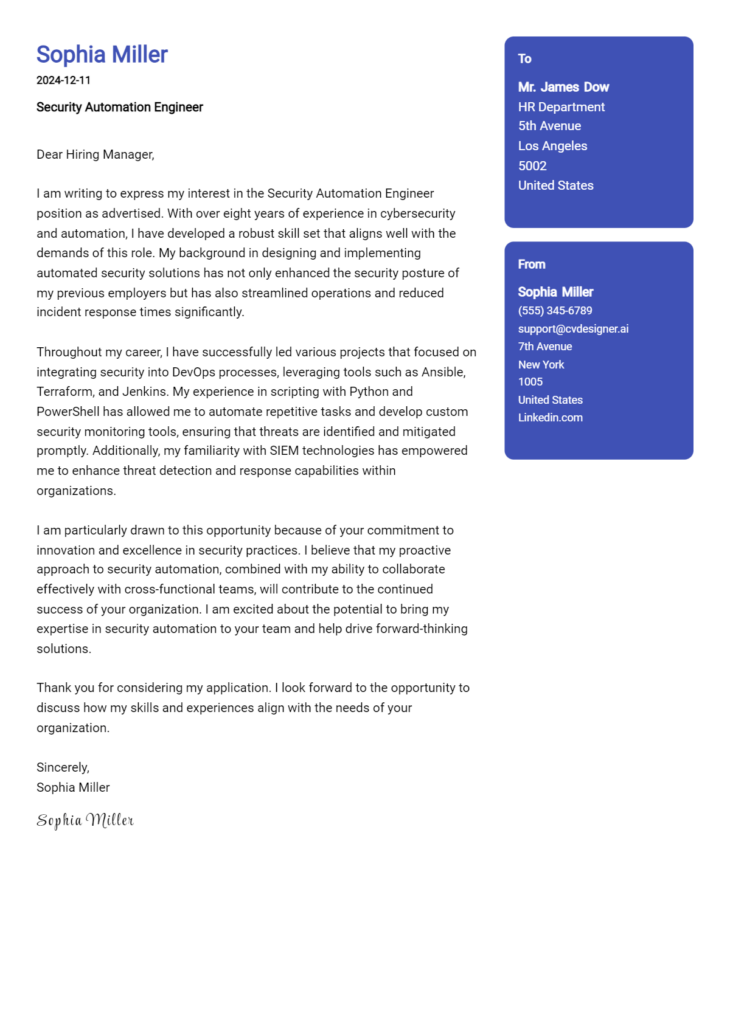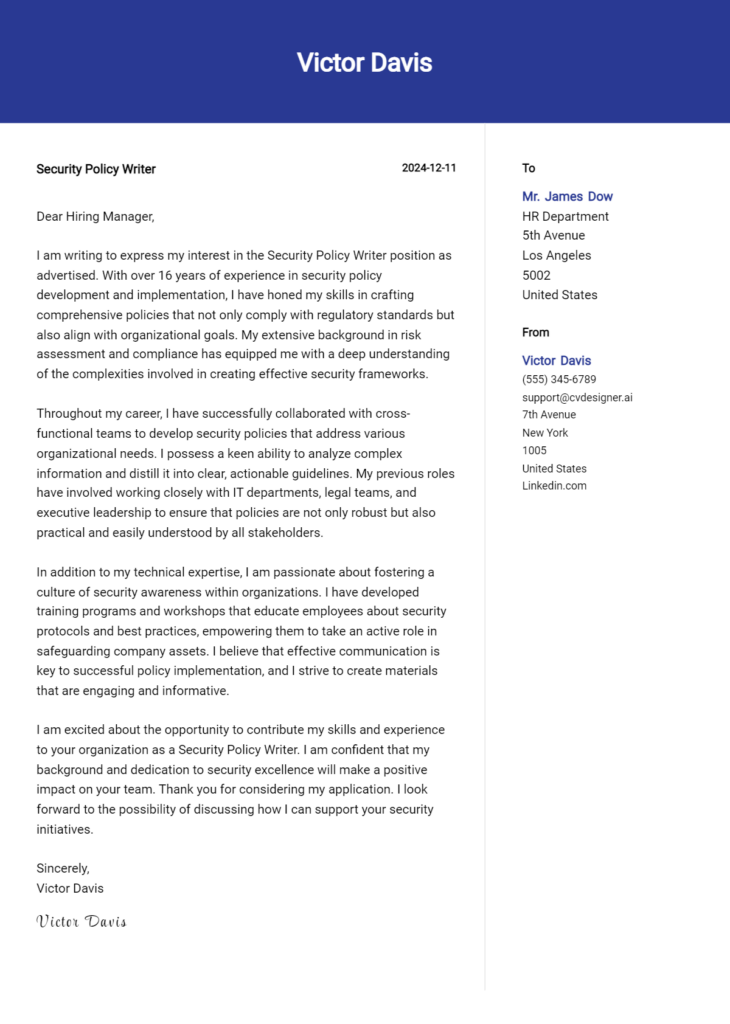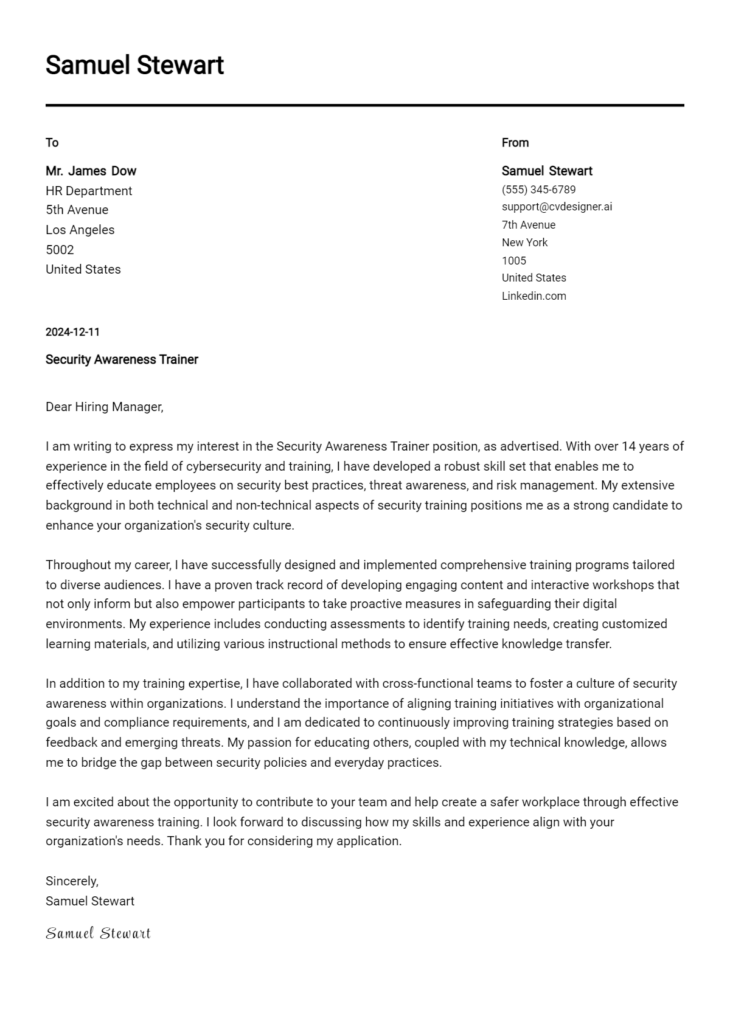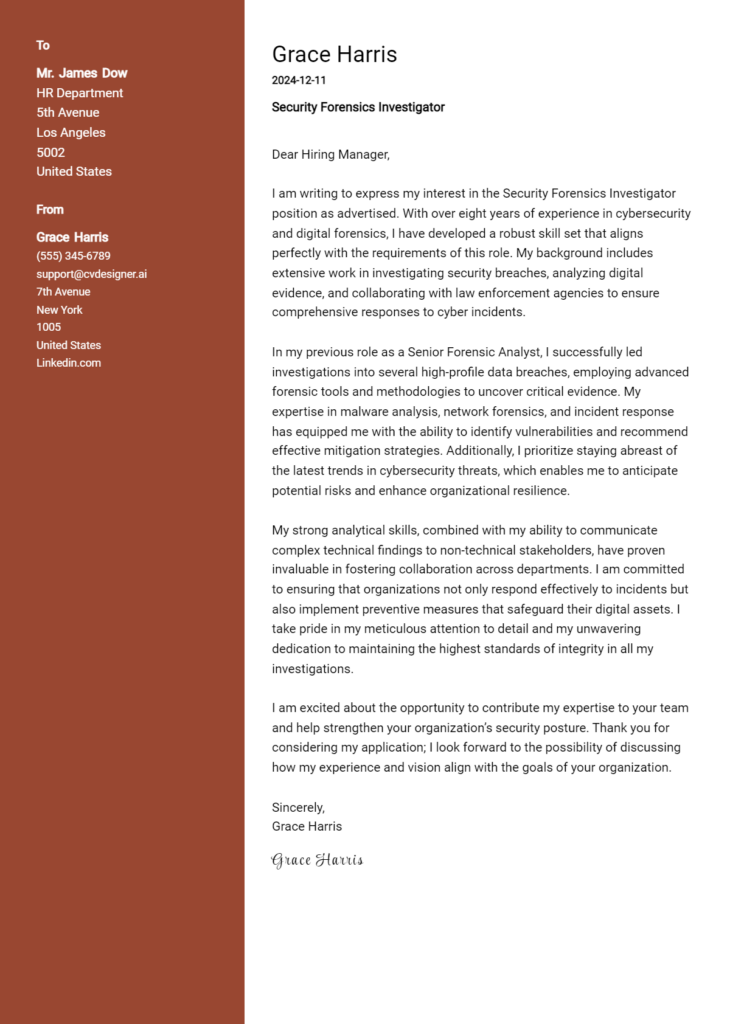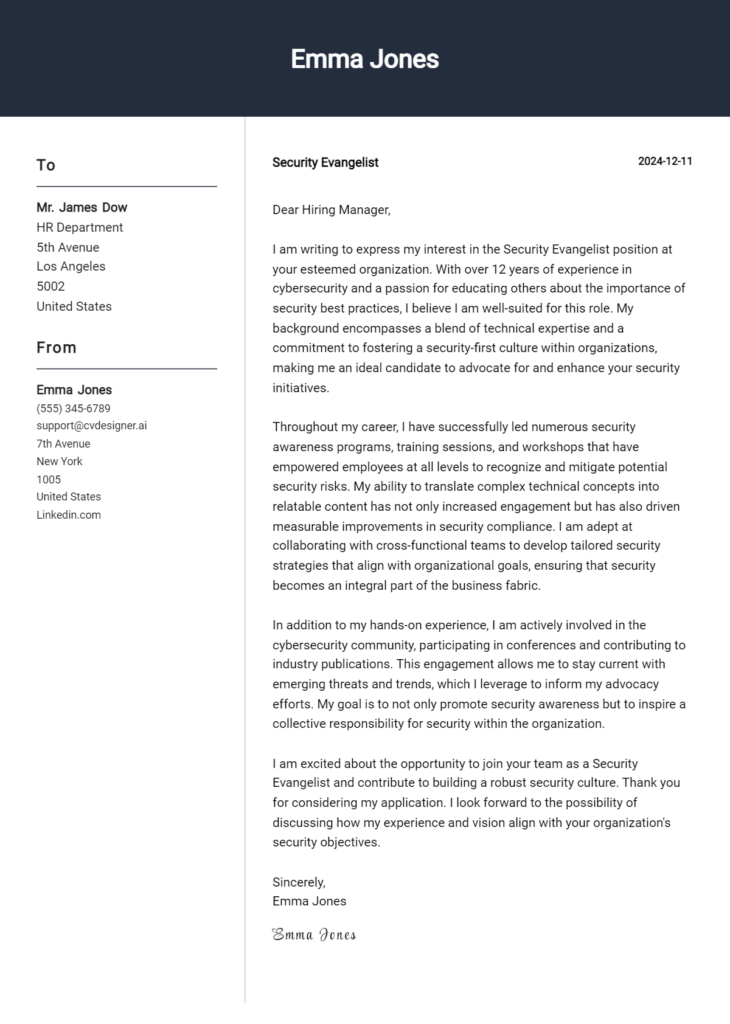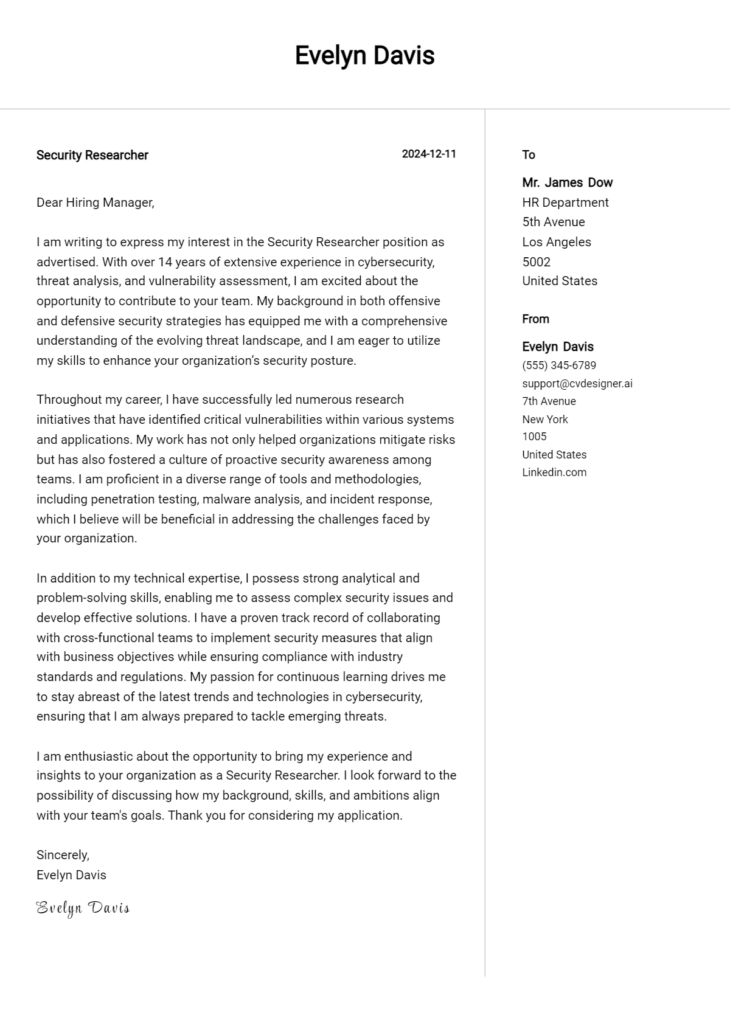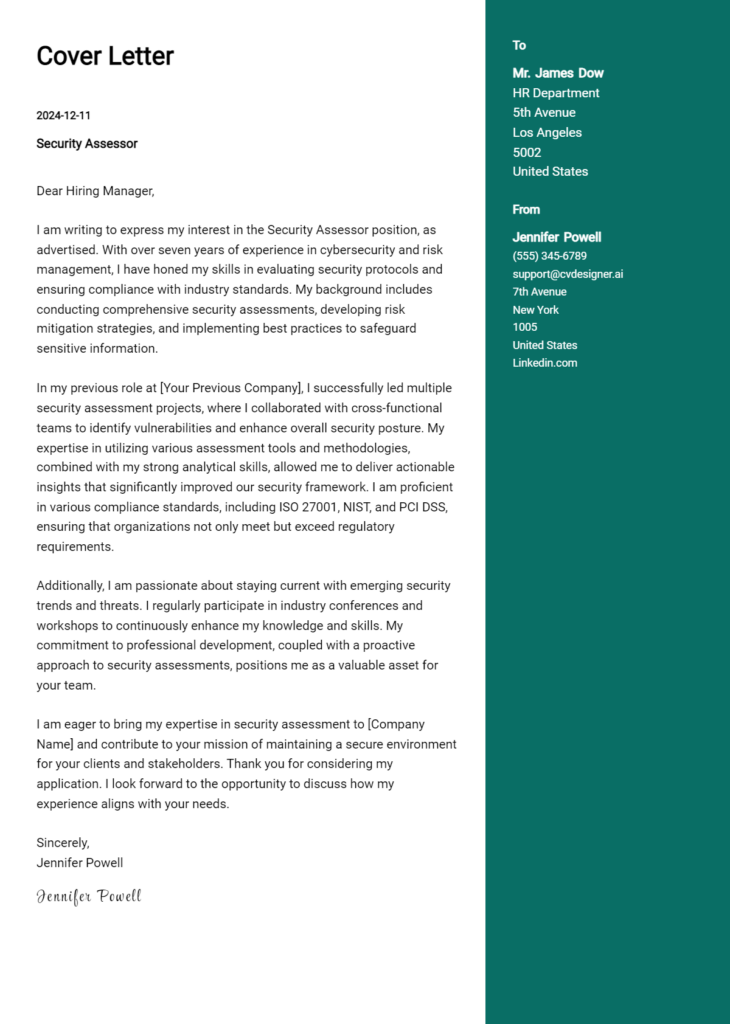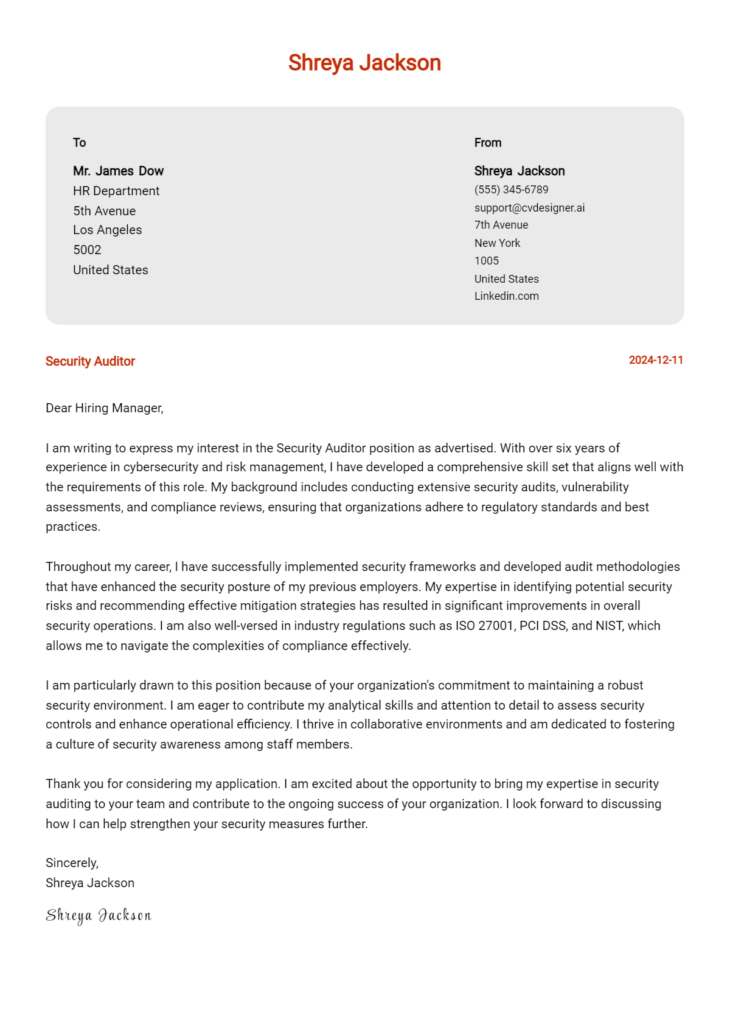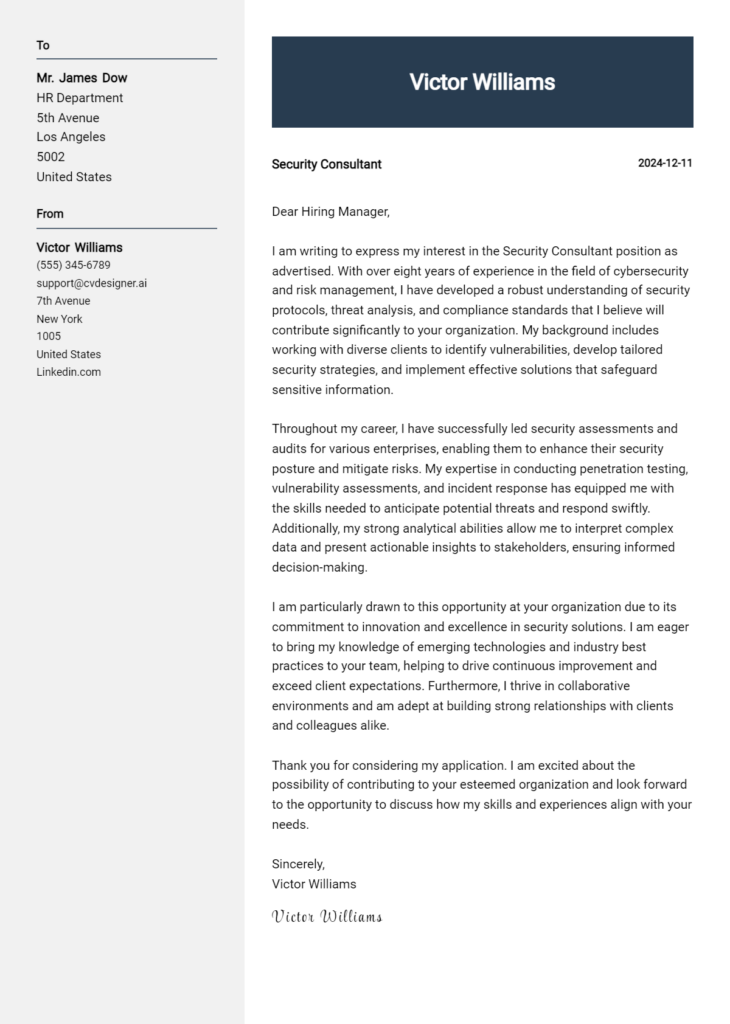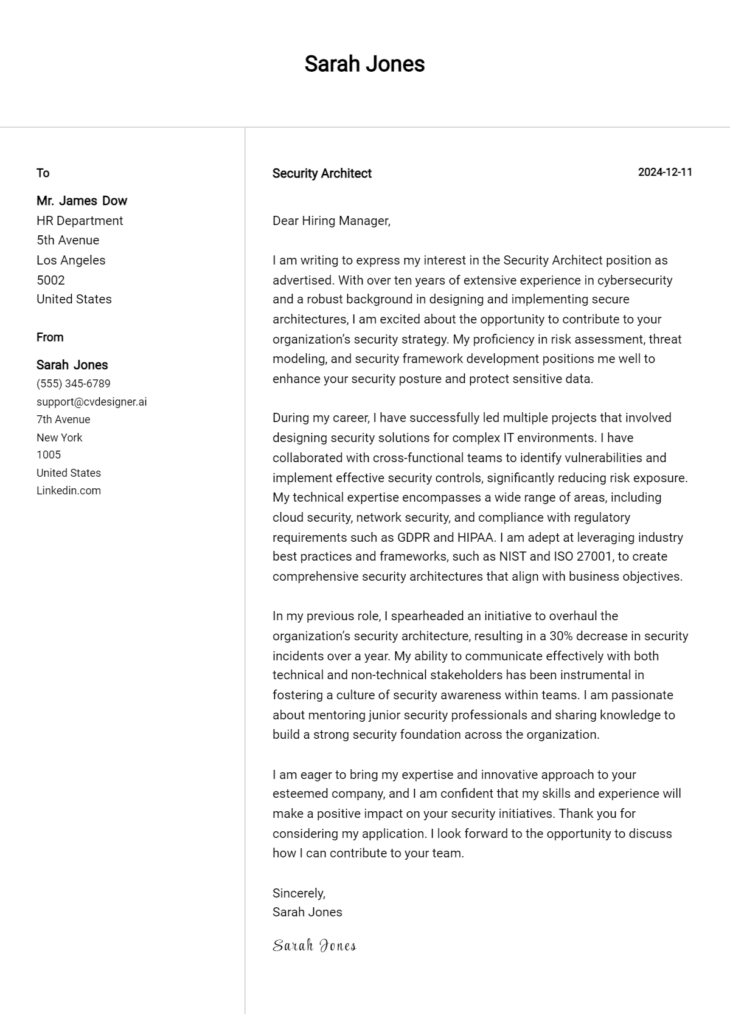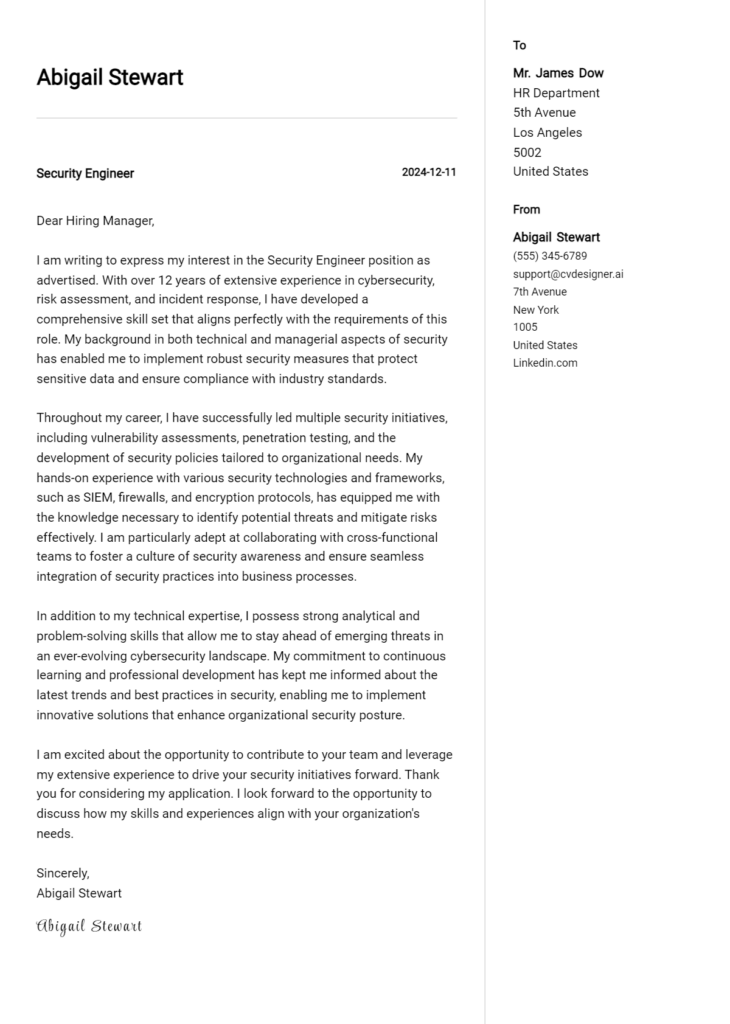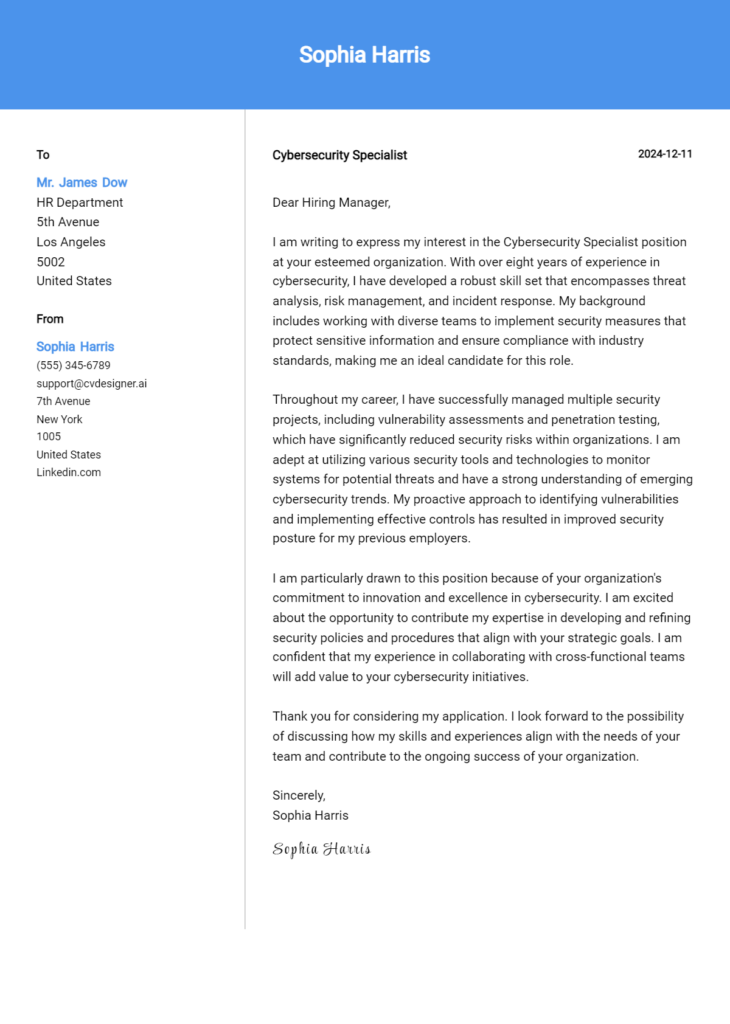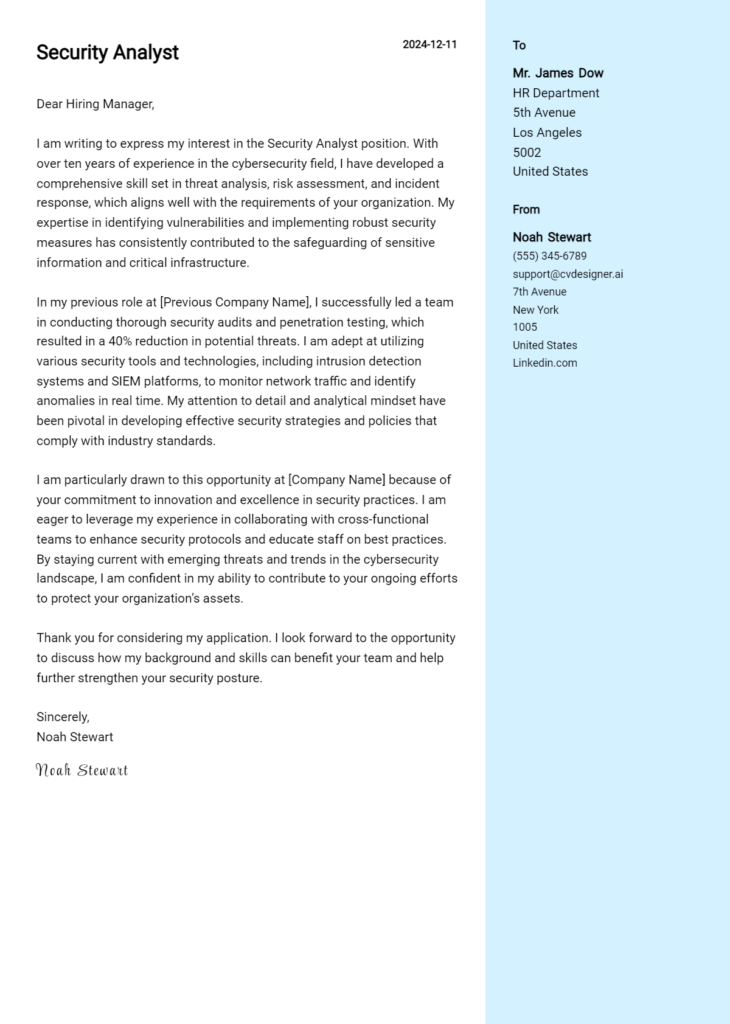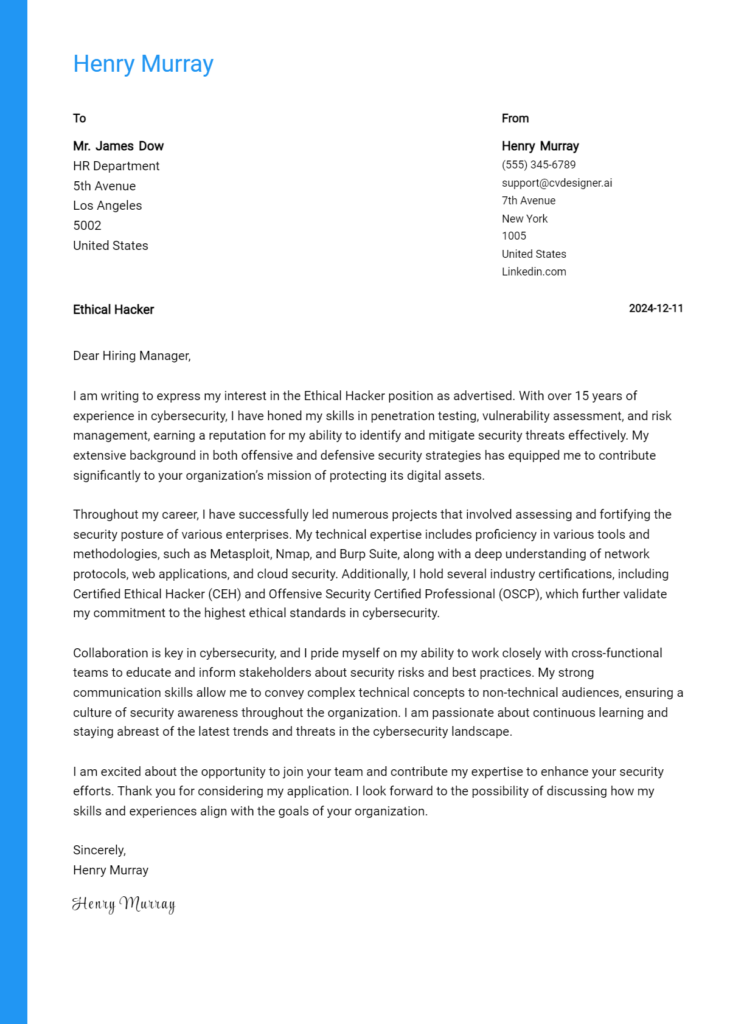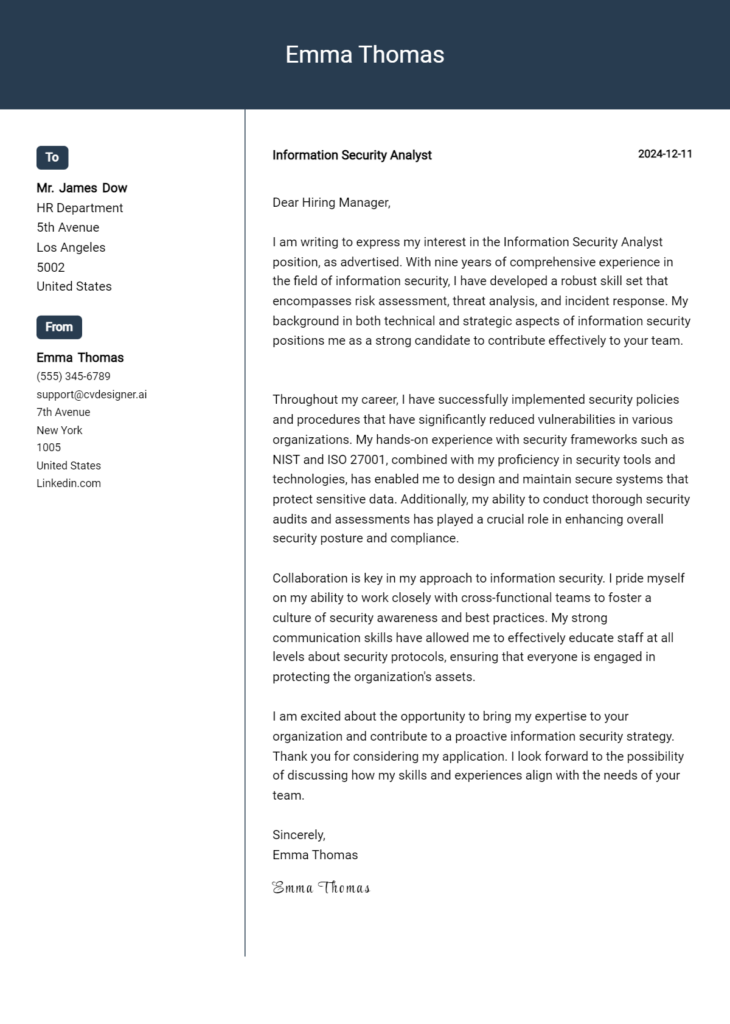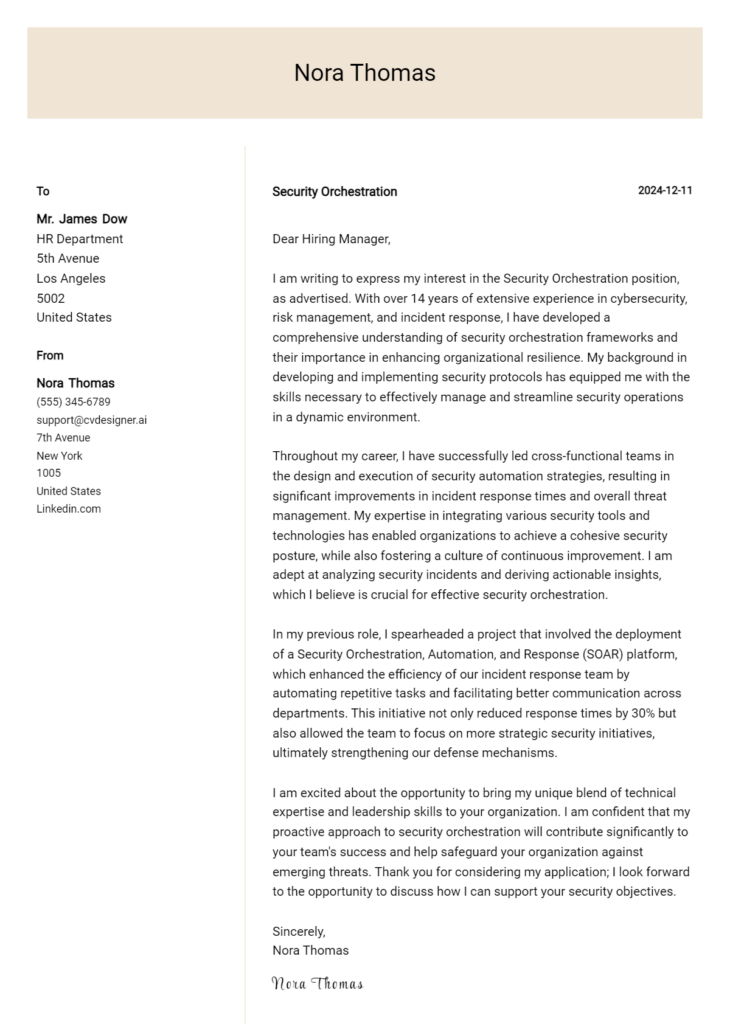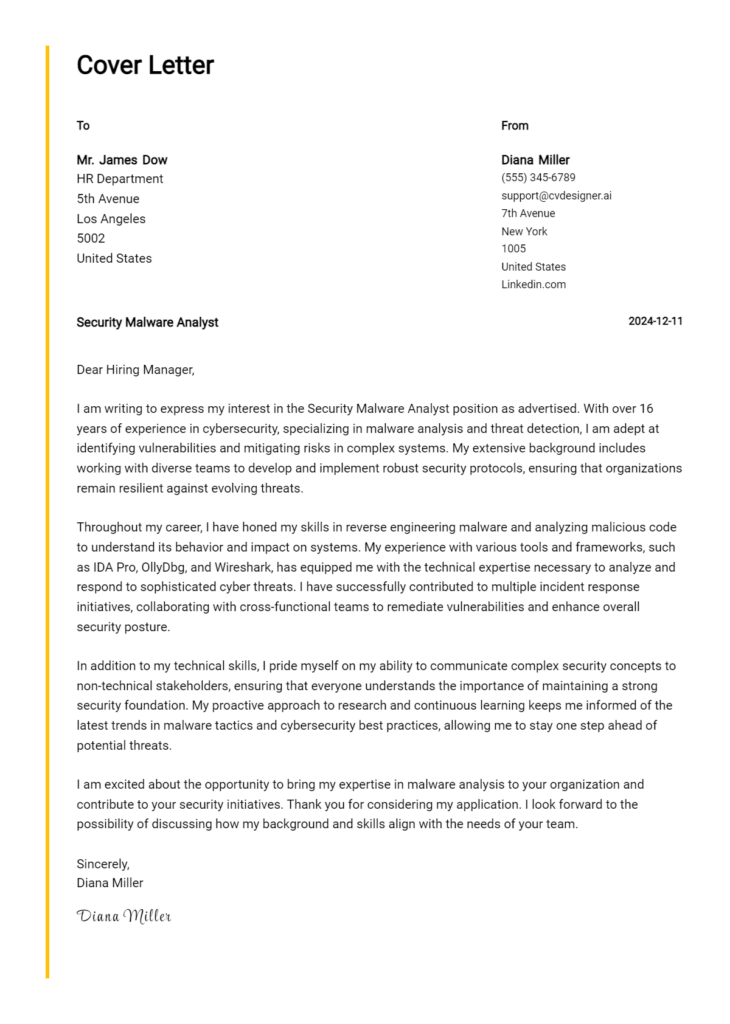Security Vulnerability Manager Cover Letter Examples
Explore additional Security Vulnerability Manager cover letter samples and guides and see what works for your level of experience or role.
How to Format a Security Vulnerability Manager Cover Letter?
Crafting a compelling cover letter for the role of a Security Vulnerability Manager is essential in showcasing your expertise in risk assessment and management. The way you format your cover letter not only reflects your professional approach but also demonstrates your ability to communicate effectively—a critical skill in the field of cybersecurity. A well-structured cover letter can capture the hiring manager's attention and convey your meticulous attention to detail, analytical abilities, and commitment to safeguarding information systems.
In this guide, we will explore how to format your cover letter, providing insights and specific examples tailored for the Security Vulnerability Manager role.
We will focus on the essential components of a professional cover letter, including:
- Cover Letter Header
- Cover Letter Greeting
- Cover Letter Introduction
- Cover Letter Body
- Cover Letter Closing
Each section significantly contributes to presenting your qualifications and professionalism. Let’s delve into each part to help you create a standout cover letter for this critical position.
Importance of the Cover Letter Header for a Security Vulnerability Manager
A well-structured cover letter header is crucial for a Security Vulnerability Manager application, as it sets the tone for the document and establishes professionalism. The header should include essential contact information, such as your name, phone number, email address, and the date, followed by the recipient's details, including their name, title, and organization. Clarity in this section ensures that the hiring manager can easily identify who you are and how to reach you. A polished header not only enhances the overall presentation of your application but also reflects your attention to detail—an important trait in the field of security.
Strong Example
John Doe 123 Security Lane Cyber City, CA 90210 (555) 123-4567 john.doe@email.com October 1, 2023 Jane Smith Hiring Manager CyberSec Solutions 456 Defense Ave Cyber City, CA 90210
Weak Example
John D. No. 123 (555) 123-4567 10/1/23 To Whom It May Concern
The Importance of a Strong Cover Letter Greeting
The greeting of your cover letter serves as the first impression for potential employers and is crucial in setting the tone for the rest of your communication. A well-crafted greeting demonstrates professionalism and personalizes your approach by addressing the hiring manager directly. This attention to detail not only shows your enthusiasm for the position but also reflects your commitment to the role of a Security Vulnerability Manager. To avoid generic greetings, take the time to research the hiring manager's name or use a specific title if a name is not available. A personalized greeting can make a significant difference in capturing the reader's attention and establishing rapport.
Strong Greeting Example
Dear Ms. Johnson,
Weak Greeting Example
To Whom It May Concern,
The Importance of an Engaging Cover Letter Introduction for a Security Vulnerability Manager
A well-crafted cover letter introduction is crucial for a Security Vulnerability Manager role, as it serves as the first impression for the hiring manager. This introductory paragraph should not only capture attention but also express the candidate's sincere interest in the position. Furthermore, it should briefly highlight key skills or achievements that align with the job requirements, demonstrating the candidate's value to the organization. A strong introduction can set the tone for the rest of the cover letter, making it essential to strike the right balance between professionalism and enthusiasm.
Strong Example
Dear [Hiring Manager's Name], As a dedicated cybersecurity professional with over seven years of experience in identifying and mitigating security vulnerabilities for major financial institutions, I am excited about the opportunity to contribute to [Company Name] as a Security Vulnerability Manager. My proven track record of developing comprehensive vulnerability management programs, alongside my expertise in risk assessment and remediation strategies, positions me uniquely to enhance your organization's security posture and protect its critical assets.
Weak Example
To whom it may concern, I am writing to apply for the Security Vulnerability Manager position. I have some experience in cybersecurity and I believe I could do a good job. I have a degree in computer science and I am familiar with various security tools.
Purpose of the Cover Letter Body for a Security Vulnerability Manager
The body of a cover letter for a Security Vulnerability Manager serves as a critical platform for candidates to articulate their skills, experiences, and the unique value they bring to the organization. This section should highlight specific projects or accomplishments that demonstrate the candidate's ability to identify, assess, and mitigate security vulnerabilities effectively. By providing concrete examples, such as successful implementation of vulnerability assessment tools or leading cross-functional teams to address security threats, candidates can showcase their technical expertise and leadership capabilities, aligning their qualifications with the needs of the company.
Strong Example
In my previous role at XYZ Corporation, I successfully led a team that implemented an enterprise-wide vulnerability management program. This initiative reduced our security vulnerabilities by 40% within the first year by introducing automated scanning tools and establishing a rigorous patch management process. Additionally, I spearheaded a cross-departmental training program that increased awareness of security best practices among employees, resulting in a 30% decrease in phishing incidents. My experience in collaborating with IT and compliance teams has equipped me with the ability to align security objectives with business goals, ensuring that security is integrated into every facet of operations.
Weak Example
I have worked in IT security for several years and know a lot about vulnerabilities. I think I would be a good fit for your company. In my last job, I did some security assessments and tried to help fix issues. I believe I can help your team, and I am looking for a new opportunity to grow.
Importance of the Cover Letter Closing for a Security Vulnerability Manager
The closing paragraph of a cover letter is crucial, particularly for a Security Vulnerability Manager, as it encapsulates the candidate's qualifications and expresses enthusiasm for the position while prompting the hiring manager to take action. A strong closing reinforces the candidate's expertise in identifying and mitigating security risks, demonstrates their commitment to the role, and encourages the reader to review the attached resume and consider scheduling an interview. Conversely, a weak closing may lack clarity or enthusiasm, failing to make a memorable impact on the hiring manager.
Strong Example
In conclusion, my extensive experience in identifying security vulnerabilities and implementing robust risk management strategies aligns perfectly with the requirements of the Security Vulnerability Manager role. I am genuinely excited about the opportunity to contribute to your team and strengthen your organization's security posture. I look forward to discussing how my skills can benefit your company in more detail. Please feel free to review my resume, and I hope to hear from you soon to schedule an interview.
Weak Example
I think I would be a good fit for this job. I hope you look at my resume. Let me know if you want to talk.
Common Mistakes to Avoid in a Security Vulnerability Manager Cover Letter
Crafting a compelling cover letter is essential for standing out in the competitive field of Security Vulnerability Management. Avoiding common mistakes can significantly enhance your chances of making a strong impression on hiring managers. Here are some frequent pitfalls and tips to steer clear of them:
Generic Content: Failing to tailor your cover letter to the specific job and company can make it seem impersonal. Always customize your letter to reflect the unique requirements of the position.
Lack of Specific Examples: Many applicants overlook the importance of providing concrete examples of their experience and achievements. Use quantifiable metrics to demonstrate your impact in previous roles.
Ignoring the Job Description: Not aligning your skills with the job description is a common error. Carefully review the job posting and incorporate relevant keywords and phrases to highlight your qualifications.
Poor Formatting: A disorganized cover letter can detract from your message. Follow a professional cover letter format to ensure clarity and readability.
Typos and Grammatical Errors: Simple mistakes can undermine your professionalism. Always proofread your letter multiple times, or consider using tools to check for errors.
Overly Lengthy Content: Many candidates write excessively long cover letters, which can lose the reader's attention. Aim for a concise yet impactful letter that conveys your key strengths succinctly.
Neglecting to Include a Call to Action: Failing to express your enthusiasm for the position and suggest a next step can leave your letter feeling incomplete. Clearly state your desire for an interview and thank the reader for their consideration.
By avoiding these common mistakes, you can create a strong cover letter that effectively communicates your qualifications for the Security Vulnerability Manager role. For inspiration, check out cover letter examples to see how others have successfully structured their letters.
Cover Letter FAQs for Security Vulnerability Manager
What should I include in my cover letter for a Security Vulnerability Manager position?
In your cover letter, focus on your experience with vulnerability assessments, risk management, and incident response. Highlight specific methodologies you've used, such as OWASP Top Ten or NIST frameworks. Discuss any relevant certifications, like CISSP or CEH, that bolster your expertise. Illustrate your ability to communicate technical information effectively to both technical and non-technical stakeholders. Additionally, mention your experience in leading teams, mentoring junior staff, or collaborating with other departments, as these are key skills for managing security vulnerabilities.
How can I demonstrate my technical skills in the cover letter?
To effectively showcase your technical skills, include examples of tools and technologies you have hands-on experience with, such as vulnerability scanners (e.g., Nessus, Qualys) or SIEM systems (e.g., Splunk). Discuss any specific projects where you identified vulnerabilities, implemented remediation strategies, or improved security posture. Use metrics to quantify your achievements, such as the percentage of vulnerabilities resolved or the time taken to remediate issues. This not only demonstrates your technical competence but also your impact on the organization’s security.
How should I tailor my cover letter for different employers?
Tailoring your cover letter involves researching each organization’s specific security challenges and culture. Start by reviewing the job description for required skills and qualifications. Align your experiences with the organization's needs by incorporating relevant keywords and phrases. If the company emphasizes a particular security framework or compliance mandate, mention your experience with it. Additionally, reflect the company’s values and mission in your writing to show that you understand their goals and are genuinely interested in contributing to their success.
How can I address gaps in my experience in the cover letter?
If you have gaps in your experience, focus on transferable skills and related experiences. Emphasize your willingness to learn and adapt, and discuss any self-study or certifications you've pursued in the meantime. You can also highlight relevant projects, even if they were part of a different role, to demonstrate your capability in managing vulnerabilities. Frame your gaps positively by discussing what you learned during those periods and how those lessons will contribute to your performance as a Security Vulnerability Manager.
Build your Cover Letter in minutes
Use an AI-powered cover letter builder and have your letter done in 5 minutes. Just select your template and our software will guide you through the process.

